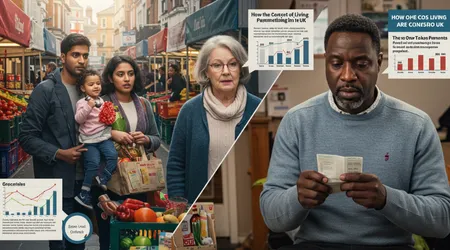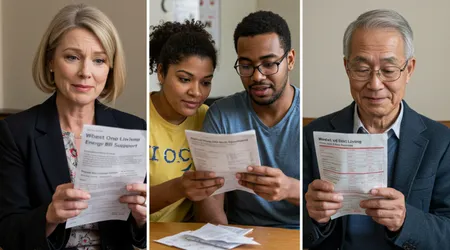How the Cost of Living Payments Are Changing This Year

The cost of living payments in 2025 mark a pivotal shift in the UK’s approach to supporting vulnerable households amid persistent economic challenges.
Inflation, though eased to 2.3% in April 2025 per the Office for National Statistics, still outpaces wage growth for many, squeezing budgets for essentials like food, energy, and rent.
These payments, delivered through schemes like the Household Support Fund (HSF) and Department for Work and Pensions (DWP) initiatives, aim to bridge that gap.
But how are they changing this year, and what does it mean for you? This guide unpacks the updates, eligibility tweaks, and practical steps to ensure you don’t miss out, blending clarity with actionable insights.
Unlike previous years, 2025 introduces a more targeted, flexible framework for cost of living payments, reflecting lessons from past rollouts.
The government’s focus is shifting from blanket lump sums to tailored aid, addressing specific regional and demographic needs.
With £742 million allocated to the HSF alone, councils now have greater autonomy to distribute funds, while DWP payments like the £450 one-off in June 2025 prioritize means-tested benefit claimants.
This evolution sparks debate: are these changes a smarter way to help, or do they risk leaving some behind? Let’s dive into the details.
This article explores the new structure of cost of living payments, who qualifies, and how to navigate the system.
From application tips to real-world examples, we’ll equip you with the knowledge to maximize support.
Whether you’re a pensioner, a low-income worker, or a family juggling bills, understanding these changes is crucial to securing your share of this financial lifeline.
The New Shape of Cost of Living Payments in 2025
The landscape of cost of living payments in 2025 reflects a nuanced response to economic pressures.
The DWP has moved away from the broad £900 payments of 2022-2024, opting for targeted sums like the £450 payment in June, automatically credited to those on benefits like Universal Credit or Pension Credit between January and March 2025.
This shift aims to streamline aid to those most in need, but it’s not without critics who argue it narrows eligibility.
Councils, empowered by the HSF’s £742 million extension, now tailor cost of living payments to local needs.
For example, Enfield Council’s £5 million allocation supports vouchers for food and energy, prioritizing families not on benefits but facing hardship.
This flexibility allows councils to address unique challenges, like rural fuel poverty or urban rent spikes, but creates a postcode lottery where support varies by region.
The government’s pivot to targeted aid also includes non-cash support. Free school meals and holiday vouchers, tied to cost of living payments, now reach more low-income families, easing childcare costs.
Yet, the absence of a universal payment raises questions: is this bespoke approach fairer, or does it complicate access for those already stretched thin?
++ Universal Credit 2025: What’s New in the Latest Update
The DWP’s decision to cap Universal Credit deductions at 15% from April 2025, down from 25%, complements these payments.
This change, announced in the Labour Budget, ensures more disposable income for claimants, amplifying the impact of cost of living payments.
For a single parent on Universal Credit, this could mean an extra £50 monthly, a small but tangible buffer against rising bills.
Critics argue the shift to localized aid risks inconsistency. In Birmingham, households can apply for up to £600 without needing benefits, while other councils limit aid to £200.
This disparity highlights the need for clear communication from local authorities to ensure eligible households don’t miss out on these vital cost of living payments.

Who Qualifies for Cost of Living Payments in 2025?
Eligibility for cost of living payments in 2025 hinges on specific criteria, primarily tied to means-tested benefits or financial hardship.
The DWP’s £450 payment targets those on Universal Credit, Income Support, or Pension Credit during spring 2025 qualifying periods.
If your claim is backdated to include these dates, you may still qualify, but contribution-based benefits like New Style JSA don’t count.
The HSF, however, casts a wider net. Households not on benefits but earning under £40,000 annually can apply for payments like Enfield’s £250 voucher scheme.
Also read: How the Two-Child Limit Affects UK Families in 2025
This inclusivity helps working families, like Sarah, a part-time retail worker in Leeds, who secured £200 for energy bills despite not claiming benefits, easing her winter budget strain.
Disability benefit recipients, such as those on PIP or DLA, may receive additional payments, like the £255 bonus due by December 2025.
These targeted boosts recognize the extra costs faced by disabled households, but the application process varies by council, demanding proactive engagement to secure funds.
Pensioners also benefit, with up to £11,900 possible through combined State Pension increases and HSF payments.
For example, John, a 70-year-old retiree, used a £200 HSF grant for heating, preserving his savings.
Yet, eligibility often requires claiming Pension Credit, which 850,000 eligible pensioners still don’t claim, per Policy in Practice.
Read more: State Pension in the UK: How Does It Work?
Navigating these criteria requires diligence. Check your benefit status, update bank details, and contact your council early, as funds are limited.
The question lingers: why does accessing help still feel like a maze for those already struggling?
How to Access and Maximize Support
Securing cost of living payments demands action, especially for HSF funds. Unlike DWP payments, which are automatic, HSF requires applications, often online.
Start by visiting your council’s website or platforms like entitledto.co.uk to check eligibility and gather documents like income proof or benefit letters.
Timing is critical. Applications for payments like Birmingham’s £600 grant reopen in late June 2025, but funds deplete quickly.
Set calendar reminders and submit early to avoid missing out. For example, Maria, a single mother in Manchester, applied early and received £300 for school uniforms, easing back-to-school stress.
Beyond cash, explore linked benefits. The Warm Home Discount, extended for 2025/26, offers £150 off energy bills for Universal Credit claimants.
Combining this with HSF vouchers can stretch your budget further, like stacking bricks to build a sturdier financial wall.
Don’t overlook smaller schemes. Free school meals, now expanded, save families £400 annually per child.
Registering for the Priority Services Register with your energy supplier can also unlock payment plans, reducing the sting of winter bills.
If payments don’t arrive, act fast. Check bank statements, verify benefit details, and contact DWP or HMRC with your National Insurance number ready. Persistence ensures you claim every penny you’re entitled to.
Challenges and Criticisms of the New Approach

The shift to targeted cost of living payments isn’t flawless. Localized HSF distribution creates disparities £600 in one council versus £200 in another.
This inconsistency frustrates households who feel their postcode dictates their support, undermining fairness in a system meant to level the playing field.
Administrative hurdles also persist. Online-only applications exclude those without digital access, like elderly pensioners.
In rural areas, limited council resources can delay processing, leaving applicants like Tom, a farmer in Cornwall, waiting weeks for a £200 grant he desperately needed for fuel.
The move away from universal payments risks missing hidden hardship cases. Low-income workers not on benefits may struggle to prove eligibility, while complex criteria can deter applications.
Advocacy groups argue for simpler, broader access to ensure no one slips through the cracks.
Despite these challenges, the government’s data-driven approach piloting rent relief and energy credits shows promise.
Early trials suggest 70% of recipients prefer non-cash aid for its direct impact on bills. Still, scaling this nationally requires better coordination to avoid gaps.
Public sentiment, reflected in X posts, shows mixed feelings. Some praise the £450 DWP payment’s simplicity, while others lament reduced universal support.
Balancing efficiency with equity remains the government’s tightrope walk in 2025.
Payment Details at a Glance
| Payment Type | Amount | Eligibility | Disbursement Period | Application Required? |
|---|---|---|---|---|
| DWP Cost of Living | £450 | Means-tested benefits (e.g., Universal Credit) | June 13–27, 2025 | No |
| HSF Local Grants | £200–£600 | Low income, varies by council | June–September 2025 | Yes |
| Disability Bonus | £255 | PIP, DLA, ADP recipients | By December 2025 | No |
| Pensioner Support | Up to £11,900 | Pension Credit, State Pension | May 2025 | Yes for HSF |
The Bigger Picture: Are These Payments Enough?
The evolution of cost of living payments reflects a broader economic strategy: stabilize households while transitioning to long-term solutions like wage increases and energy reforms.
The 4.1% State Pension rise and 6.7% benefits uplift from April 2025 help, but inflation’s persistent bite 2.3% in April still outstrips many incomes.
Consider this analogy: these payments are like a lifeboat in a stormy sea vital but not a permanent fix.
For families like Sarah’s, £450 covers a month’s groceries, but systemic issues like housing costs demand bigger reforms. Can temporary payments truly bridge the gap to financial stability?
Other measures, like the expanded free childcare for under-fives from September 2025, ease pressures, but gaps remain.
Policy in Practice estimates £23 billion in unclaimed benefits annually, suggesting many miss out due to awareness or access barriers. This underscores the need for clearer outreach.
The government’s focus on targeted aid aligns with fiscal constraints, but critics argue it’s a half-measure.
A universal basic income trial, floated in think tanks, could simplify support but faces political hurdles. For now, cost of living payments remain a critical, if imperfect, tool.
Ultimately, these payments are a stepping stone. Households must pair them with budgeting strategies using benefits calculators or negotiating payment plans to maximize impact.
The real test is whether 2025’s changes empower families or merely tide them over.
Frequently Asked Questions
Q: Can I get the £450 payment if I start benefits after March 2025?
A: No, you must be on qualifying benefits between January and March 2025. Backdated claims may qualify.
Q: Do HSF payments affect my benefits?
A: No, these grants are non-taxable and don’t impact other benefits or tax credits.
Q: What if I don’t receive my payment by June’s end?
A: Check your bank account, verify benefit details, and contact DWP or your council with your National Insurance number.
Q: Can working households apply for HSF?
A: Yes, low-income households under £40,000 annually may qualify, depending on council rules.
